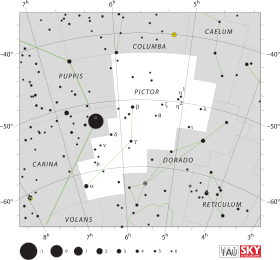Gamma Pictoris
γ Pictoris
| Ascension droite | 05h 49m 49,662s[1] |
|---|---|
| Déclinaison | −56° 09′ 59,981″[1] |
| Constellation | Peintre |
| Magnitude apparente | 4,50[2] |
Localisation dans la constellation : Peintre | |
| Type spectral | K1III[3] |
|---|---|
| Indice U-B | +0,98[4] |
| Indice B-V | +1,10[4] |
| Vitesse radiale | +15,7 ± 0,8 km/s[5] |
|---|---|
| Mouvement propre |
μα = +81,13 mas/a[1] μδ = −71,12 mas/a[1] |
| Parallaxe | 18,45 ± 0,15 mas[1] |
| Distance | 177 ± 1 a.l. (∼ 54,3 pc)[1] |
| Magnitude absolue | +0,83[1] |
| Masse | 1,59 M☉[6] |
|---|---|
| Rayon | 11 R☉[6] |
| Gravité de surface (log g) | 2,56[6] |
| Luminosité | 60,75 L☉[2] |
| Température | 4 600 K[7] |
| Métallicité | +0,15 [Fe/H][2] |
| Rotation | 6,4 km/s[8] |
Désignations
Gamma Pictoris (γ Pictoris / γ Pic) est une étoile orangée de la constellation australe du Peintre. C'est une étoile visible à l’œil nu avec une magnitude apparente de +4,50[2]. D'après les mesures de sa parallaxe réalisées par le satellite Hipparcos, elle est distante d’environ ∼ 177 a.l. (∼ 54,3 pc) du Soleil[1], et elle s'éloigne du système solaire à une vitesse radiale de +15,7 km/s[5].
Gamma Pictoris est une étoile géante rouge de type spectral K1III[3]. Elle fait 1,59 fois la masse du Soleil et son rayon s'est étendu jusqu'à faire 11 fois celui du Soleil[6]. L'étoile est 61 fois plus lumineuse que le Soleil[2] et elle émet sa lumière depuis sa photosphère à une température effective d'environ 4 600 K[7]. Gamma Pictoris ne possède pas de compagnon connu qui lui serait associé[10].
Références[modifier | modifier le code]
- (en) Cet article est partiellement ou en totalité issu de l’article de Wikipédia en anglais intitulé « Gamma Pictoris » (voir la liste des auteurs).
- (en) F. van Leeuwen, « Validation of the new Hipparcos reduction », Astronomy and Astrophysics, vol. 474, no 2, , p. 653–64 (DOI 10.1051/0004-6361:20078357, Bibcode 2007A&A...474..653V, arXiv 0708.1752)
- (en) E. Anderson et Ch. Francis, « XHIP: An extended hipparcos compilation », Astronomy Letters, vol. 38, no 5, , p. 331 (DOI 10.1134/S1063773712050015, Bibcode 2012AstL...38..331A, arXiv 1108.4971)
- (en) D. Hoffleit et W. H. Warren, « VizieR Online Data Catalog: Bright Star Catalogue, 5th Revised Ed. (Hoffleit+, 1991) », VizieR On-line Data Catalog: V/50. Originellement publié dans : 1964BS....C......0H, vol. 5050, 1995 bibcode=1995ycat.5050....0
- (en) Mallama, « Sloan Magnitudes for the Brightest Stars », The périodique of the American Association of Variable Star Observers, vol. 42, , p. 443 (Bibcode 2014JAVSO..42..443M)
- (en) G. A. Gontcharov, « Pulkovo Compilation of Radial Velocities for 35 495 Hipparcos stars in a common system », Astronomy Letters, vol. 32, no 11, , p. 759 (DOI 10.1134/S1063773706110065, Bibcode 2006AstL...32..759G, arXiv 1606.08053)
- (en) Allende Prieto et D. L. Lambert, « Fundamental parameters of nearby stars from the comparison with evolutionary calculations: Masses, radii and effective temperatures », Astronomy and Astrophysics, vol. 352, , p. 555 (Bibcode 1999A&A...352..555A, arXiv astro-ph/9911002)
- (en) G. A. Gontcharov, « Red giant clump in the Tycho-2 catalogue », Astronomy Letters, vol. 34, no 11, , p. 785 (DOI 10.1134/S1063773708110078, Bibcode 2008AstL...34..785G, arXiv 1607.00619)
- (en) J. R. De Medeiros et al., « A catalog of rotational and radial velocities for evolved stars », Astronomy & Astrophysics, vol. 561, , A126 (DOI 10.1051/0004-6361/201220762, Bibcode 2014A&A...561A.126D, arXiv 1312.3474)
- (en) * gam Pic -- High proper-motion Star sur la base de données Simbad du Centre de données astronomiques de Strasbourg.
- (en) P. P. Eggleton et A. A. Tokovinin, « A catalogue of multiplicity among bright stellar systems », Monthly Notices of the Royal Astronomical Society, vol. 389, no 2, , p. 869–879 (DOI 10.1111/j.1365-2966.2008.13596.x, Bibcode 2008MNRAS.389..869E, arXiv 0806.2878)
Liens externes[modifier | modifier le code]
- (en) Gamma Pictoris sur la base de données Simbad du Centre de données astronomiques de Strasbourg.

